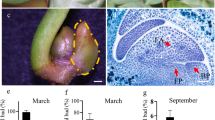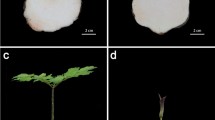Abstract
Key message
Overexpression of BpAP1 could cause early flowering in birch. BpAP1 affected the expression of many flowering-related unigenes and diterpenoid biosynthesis in transgenic birch, and BpPI was a putative target gene of BpAP1.
Abstract
APETALA1 (AP1) is an MADS-box transcription factor that is involved in the flowering process in plants and has been a focus of genetic studies examining flower development. Here, we carried out transcriptome analysis of birch (Betula platyphylla Suk.), including BpAP1 overexpression lines, BpAP1 suppression lines, and non-transgenic line (NT). Compared with NT, we detected 8302 and 7813 differentially expressed unigenes in 35S::BpAP1 and 35S::BpAP1RNAi transgenic lines, respectively. Overexpression and suppression of BpAP1 in birch affected diterpenoid biosynthesis and altered expression of many flowering-related unigenes. Moreover, combining information from the RNA-seq database and the birch genome, we predicted downstream target genes of BpAP1. Among the 166 putative target genes of BpAP1, there was a positive correlation between BpAP1 and BpPI. These results provide references for further examining the relationship between BpAP1 and its target genes, and reveal that BpAP1 functions as a transcription regulator in birch.











Similar content being viewed by others
Abbreviations
- AP1 :
-
APETALA1
- NT:
-
Non-transgenic line
- FT :
-
FLOWERING LOCUS T
- SOC1 :
-
SUPPRESSOR OF OVEREXPRESSION OF CO1
- LFY :
-
LEAFY
- PI :
-
PISTILLATA
- ChIP:
-
Chromatin immunoprecipitation
- GGDP:
-
Geranylgeranyl diphosphate
- RNA-seq:
-
RNA sequencing
- WPM:
-
Woody plant medium
- Nr:
-
Non-redundant
- KEGG:
-
Kyoto encyclopedia of genes and genomes
- COG:
-
Clusters of orthologous groups
- GO:
-
Gene ontology
- RPKM:
-
Reads per kb per million reads
- DEUs:
-
Differentially expressed unigenes
- DETGs:
-
Differentially expressed target genes
References
Abe M, Kobayashi Y, Yamamoto S, Daimon Y, Yamaguchi A, Ikeda Y, Ichinoki H, Notaguchi M, Goto K, Araki T (2005) FD, a bZIP protein mediating signals from the floral pathway integrator FT at the shoot apex. Science 309:1052–1056
Altschul SF, Madden TL, Schäffer AA, Zhang J, Zhang Z, Miller W, Lipman DJ (1997) Gapped BLAST and PSI-BLAST: a new generation of protein database search programs. Nucleic Acids Res 25:3389–3402
Ashburner M, Ball CA, Blake JA, Botstein D, Butler H, Cherry JM, Davis AP, Dolinski K, Dwight SS, Eppig JT, Harris MA, Hill DP, Issel-Tarver L, Kasarskis A, Lewis S, Matese JC, Richardson JE, Ringwald M, Rubin GM, Sherlock G (2000) Gene ontology: tool for the unification of biology. Nat Genet 25(1):25–29
Audic S, Claverie JM (1997) The significance of digital gene expression profiles. Genome Res 7:986–995
Cardon GH, Hohmann S, Nettesheim K, Saedler H, Huijser P (1997) Functional analysis of the Arabidopsisthaliana SBP-box gene SPL3: a novel gene involved in the floral transition. Plant J 12:367–377
Chang S, Puryear J, Cairney J (1993) A simple and efficient method for isolating RNA from pine trees. Plant Mol Biol Rep 11:113–116
Conesa A, Götz S, García-Gómez JM, Terol J, Talón M, Robles M (2005) Blast2GO: a universal tool for annotation, visualization and analysis in functional genomics research. Bioinformatics 21:3674–3676
de Hoon MJ, Imoto S, Nolan J, Miyano S (2004) Open source clustering software. Bioinformatics 20(9):1453–1454
Dijkstra C, Adams E, Bhattacharya A, Page AF, Anthony P, Kourmpetli S, Power JB, Lowe KC, Thomas SG, Hedden P, Phillips AL, Davey MR (2008) Over-expression of a gibberellin 2-oxidase gene from Phaseoluscoccineus L. enhances gibberellin inactivation and induces dwarfism in Solanum species. Plant Cell Rep 27:463–470
Esumi T, Tao R, Yonemori K (2007) Relationship between floral development and transcription levels of LEAFY and TERMINALFLOWER1 homologs in Japanese pear (Pyruspyrifolia Nakai) and quince (Cydoniao blonga Mill.). J Jpn Soc Hortic Sci 76:294–304
Garcia-Martinez JL, Lopez-Diaz I, Sanchez-Beltran MJ, Phillips AL, Ward DA, Gaskin P, Hedden P (1997) Isolation and transcript analysis of gibberellin 20-oxidase genes in pea and bean in relation to fruit development. Plant Mol Biol 33:1073–1084
Grabherr MG, Haas BJ, Yassour M, Levin JZ, Thompson DA, Amit I, Adiconis X, Fan L, Raychowdhury R, Zeng QD, Chen ZH, Mauceli E, Hacohen N, Gnirke A, Rhind N, di Palma F, Birren BW, Nusbaum C, Lindblad-Toh K, Friedman N, Regev A (2011) Full-length transcriptome assembly from RNA-Seq data without a reference genome. Nat Biotechnol 29:644–652
Hsu CY, Liu Y, Luthe DS, Yuceer C (2006) Poplar FT2 shortens the juvenile phase and promotes seasonal flowering. Plant Cell 18:1846–1861
Huang H, Wang S, Jiang J, Liu G, Li H, Chen S, Xu H (2014) Overexpression of BpAP1 induces early flowering and produces dwarfism in Betula platyphylla × Betula pendula. Physiol Plant 151:495–506
Huang J, Lu X, Yan H, Chen S, Zhang W, Huang R, Zheng Y (2012) Transcriptome characterization and sequencing-based identification of salt-responsive genes in Millettia pinnata, a semi-mangrove plant. DNA Res 19:195–207
Huang J, Tang D, Shen Y, Qin B, Hong L, You A, Li M, Wang X, Yu H, Gu M, Cheng Z (2010) Activation of gibberellin 2-oxidase 6 decreases active gibberellin levels and creates a dominant semi-dwarf phenotype in rice (Oryzasativa L.). J Genet Genomics 37:23–36
Irish VF, Sussex IM (1990) Function of the apetala-1 gene during Arabidopsis floral development. Plant Cell 2:741–753
Jack T (2004) Molecular and genetic mechanisms of floral control. Plant Cell 16(suppl 1):S1–S17
Jarvinen P, Lemmetyinen J, Savolainen O, Sopanen T (2003) DNA sequence variation in BpMADS2 gene in two populations of Betula pendula. Mol Ecol 12:369–384
Kanehisa M, Goto S (2000) KEGG: Kyoto encyclopedia of genes and genomes. Nucleic Acids Res 28:27–30
Kaufmann K, Wellmer F, Muino JM, Ferrier T, Wuest SE, Kumar V, Serrano-Mislata A, Madueno F, Krajewski P, Meyerowitz EM, Angenent GC, Riechmann JL (2010) Orchestration of floral initiation by APETALA1. Science 328:85–89
Klein J, Saedler H, Huijser P (1996) A new family of DNA binding proteins includes putative transcriptional regulators of the Antirrhinum majus floral meristem identity gene SQUAMOSA. Mol Gen Genet 250:7–16
Lamb RS, Hill TA, Tan QKG, Irish VF (2002) Regulation of APETALA3 floral homeotic gene expression by meristem identity genes. Development 129:2079–2086
Lee JH, Yoo SJ, Park SH, Hwang I, Lee JS, Ahn JH (2007) Role of SVP in the control of flowering time by ambient temperature in Arabidopsis. Gene Dev 21:397–402
Lemmetyinen J, Pennanen T, Lännenpää M, Sopanen T (2001) Prevention of flower formation in dicotyledons. Mol Breed 7:341–350
Livak KJ, Schmittgen TD (2001) Analysis of relative gene expression data using real-time quantitative PCR and the 2−ΔΔCT Method. Methods 25:402–408
Lloyd G, McCown B (1980) Commercially-feasible micropropagation of mountain laurel, Kalmia latifolia, by use of shoot-tip culture. Combined Proc Int Plant Prop Soc 30:421–427
Marioni JC, Mason CE, Mane SM, Stephens M, Gilad Y (2008) RNA-seq: an assessment of technical reproducibility and comparison with gene expression arrays. Genome Res 18:1509–1517
Michaels SD, Ditta G, Gustafson-Brown C, Pelaz S, Yanofsky M, Amasino RM (2008) AGL24 acts as a promoter of flowering in Arabidopsis and is positively regulated by vernalization. Plant J 33(5):867–874
Mortazavi A, Williams BA, McCue K, Schaeffer L, Wold B (2008) Mapping and quantifying mammalian transcriptomes by RNA-Seq. Nat Methods 5:621–628
Ng M, Yanofsky MF (2001) Activation of the Arabidopsis B class homeotic genes by APETALA1. Plant Cell 13(4):739–753
Norusis M (2008) SPSS 16.0 statistical procedures companion. Prentice Hall Press
Olszewski N, Sun TP, Gubler F (2002) Gibberellin signaling: biosynthesis, catabolism, and response pathways. Plant Cell 14(Suppl 1):S61–S80
Pelaz S, Gustafson-Brown C, Kohalmi SE, Crosby WL, Yanofsky MF (2001) APETALA1 and SEPALLATA3 interact to promote flower development. Plant J 26:385–394
Pillitteri LJ, Lovatt CJ, Walling LL (2004) Isolation and characterization of a TERMINAL FLOWER homolog and its correlation with juvenility in citrus. Plant Physiol 135(3):1540–1551
Poupin MJ, Federici F, Medina C, Matus JT, Timmermann T, Arce-Johnson P (2007) Isolation of the three grape sub-lineages of B-class MADS-box TM6, PISTILLATA and APETALA3 genes which are differentially expressed during flower and fruit development. Gene 404:10–24
Riechmann JL, Wang M, Meyerowitz EM (1996) DNA-binding properties of Arabidopsis MADS domain homeotic proteins APETALA1, APETALA3, PISTILLATA and AGAMOUS. Nucleic Acids Res 24:3134–3141
Samach A, Onouchi H, Gold SE, Ditta GS, Schwarz-Sommer Z, Yanofsky MF, Coupland G (2000) Distinct roles of CONSTANS target genes in reproductive development of Arabidopsis. Science 288:1613–1616
Searle I, He YH, Turck F, Vincent C, Fornara F, Krober S, Amasino RA, Coupland G (2006) The transcription factor FLC confers a flowering response to vernalization by repressing meristem competence and systemic signaling in Arabidopsis. Gene Dev 20:898–912
Sessions A, Yanofsky MF, Weigel D (2000) Cell-cell signaling and movement by the floral transcription factors LEAFY and APETALA1. Science 289:779–782
Sundstrom JF, Nakayama N, Glimelius K, Irish VF (2006) Direct regulation of the floral homeotic APETALA1 gene by APETALA3 and PISTILLATA in Arabidopsis. Plant J 46:593–600
Tamura K, Peterson D, Peterson N, Stecher G, Nei M, Kumar S (2011) MEGA5: molecular evolutionary genetics analysis using maximum likelihood, evolutionary distance, and maximum parsimony methods. Mol Biol Evol 28(10):2731–2739
Team RC (2012) R: a language and environment for statistical computing
Thomas SG, Phillips AL, Hedden P (1999) Molecular cloning and functional expression of gibberellin 2-oxidases, multifunctional enzymes involved in gibberellin deactivation. Proc Natl Acad Sci USA 96:4698–4703
Towbin H, Staehelin T, Gordon J (1979) Electrophoretic transfer of proteins from polyacrylamide gels to nitrocellulose sheets: procedure and some applications. Proc Natl Acad Sci USA 76:4350–4354
Turck F, Fornara F, Coupland G (2008) Regulation and identity of florigen: FLOWERING LOCUS T moves center stage. Annu Rev Plant Biol 59:573–594
Wagner D, Sablowski RW, Meyerowitz EM (1999) Transcriptional activation of APETALA1 by LEAFY. Science 285:582–584
Wang JW, Czech B, Weigel D (2009a) miR156-regulated SPL transcription factors define an endogenous flowering pathway in Arabidopsis thaliana. Cell 138:738–749
Wang Z, Gerstein M, Snyder M (2009b) RNA-Seq: a revolutionary tool for transcriptomics. Nat Rev Genet 10:57–63
Wellmer F, Alves-Ferreira M, Dubois A, Riechmann JL, Meyerowitz EM (2006) Genome-wide analysis of gene expression during early Arabidopsis flower development. PLoS Genet 2:e117
Wigge PA, Kim MC, Jaeger KE, Busch W, Schmid M, Lohmann JU, Weigel D (2005) Integration of spatial and temporal information during floral induction in Arabidopsis. Science 309:1056–1059
Yamaguchi S (2008) Gibberellin Metabolism and its Regulation. Annu Rev Plant Biol 59:225–251
Yang H, Mo H, Fan D, Cao Y, Cui S, Ma L (2012) Overexpression of a histone H3K4 demethylase, JMJ15, accelerates flowering time in Arabidopsis. Plant Cell Rep 31(7):1297–1308
Yu H, Xu Y, Tan EL, Kumar PP (2002) AGAMOUS-LIKE 24, a dosage-dependent mediator of the flowering signals. Proc Natl Acad Sci 99(25):16336–16341
Zhang JZ, Ai XY, Sun LM, Zhang DL, Guo WW, Deng XX, Hu CG (2011) Transcriptome profile analysis of flowering molecular processes of early flowering trifoliate orange mutant and the wild-type [Poncirus trifoliata (L.) Raf.] by massively parallel signature sequencing. BMC Genom 12:63
Zhang X, Feng B, Zhang Q, Zhang D, Altman N, Ma H (2005) Genome-wide expression profiling and identification of gene activities during early flower development in Arabidopsis. Plant Mol Biol 58:401–419
Acknowledgments
This work was supported by the Fundamental Research Funds for the Central Universities, 2572015BA02.
Conflict of interest
The authors declare that they have no conflict of interest.
Author information
Authors and Affiliations
Corresponding author
Additional information
Communicated by Z.-Y. Wang.
Electronic supplementary material
Below is the link to the electronic supplementary material.
Rights and permissions
About this article
Cite this article
Huang, H., Chen, S., Li, H. et al. Next-generation transcriptome analysis in transgenic birch overexpressing and suppressing APETALA1 sheds lights in reproduction development and diterpenoid biosynthesis. Plant Cell Rep 34, 1663–1680 (2015). https://doi.org/10.1007/s00299-015-1817-6
Received:
Revised:
Accepted:
Published:
Issue Date:
DOI: https://doi.org/10.1007/s00299-015-1817-6




